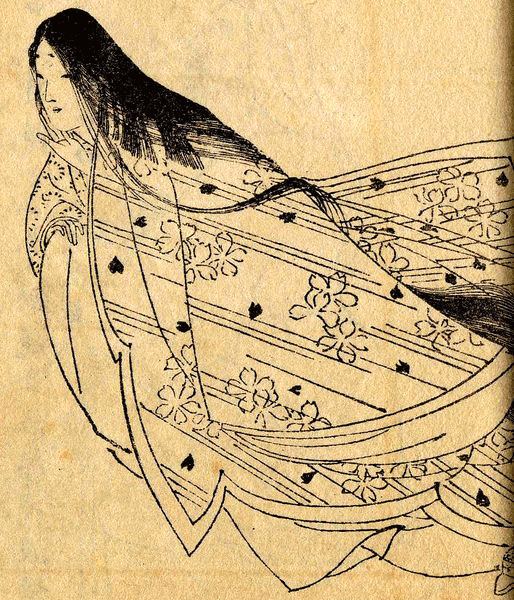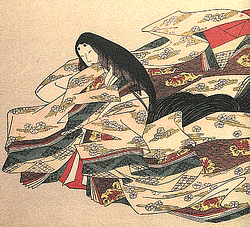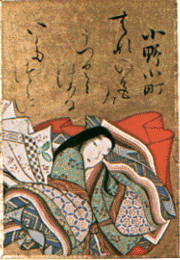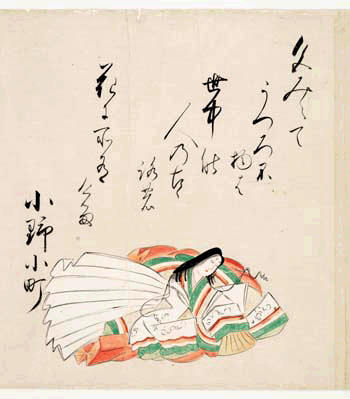————
ONO NO KOMACHI
History’s Most Beautiful Women

Famous Japanese waka poet, one of the Rokkasen — the Six best Waka poets of the early Heian period. She was noted as a rare beauty; Komachi is a symbol of a beautiful woman in Japan. She is also numbered as one of the Thirty-six Poetry Immortals.
Life and legends

The place of Komachi’s birth and death is uncertain. According to one tradition, she was born in what is now Akita Prefecture, daughter of Yoshisada, “Lord of Dewa”.[1] Her social status is also uncertain. She may have been a low-ranking consort or a lady-in-waiting of an emperor, possibly Emperor Nimmyō (r. 833-850).
As a poet, Komachi specialized in erotic love themes, expressed in complex poems.[2] Most of her waka are about anxiety, solitude or passionate love. She is the only female poet referred to in the preface of the Kokin Wakashū, which describes her style as “containing naivety in old style but also delicacy”.
There are legends about Komachi in love. The most famous is a story about her relationship with Fukakusa no Shosho, a high-ranking courtier. Komachi promised that if he visited her continuously for a hundred nights, then she would become his lover. Fukakusa no Shosho visited her every night, but failed once towards the end. Despairing, he fell ill and subsequently died. When Komachi learned of his death she was overcome with sadness.
Ono no Komachi’s Poetry
Very little is known about this Japanese poetess, and most of it is legendary. She lived around 850 C.E. (b. 834?) during the Heian period. The story about her is that she was a woman of unparallelled beauty in her youth and enjoyed the attention of many suitors. She was, however, haughty and cruel, breaking many hearts. She was punished by living to an old age and dying as a destitute and ugly hag in loneliness. The legend is almost certainly false, but the passionate nature of her loves survives (minus the didactic ending) to this day. In fact, the town of Ogachi in Akita prefecture celebrates an annual Komachi Festival on the second Sunday of June (legend has it that she was born in the village of Ono in Ogachi). There is a shrine dedicated to her.
What is certain about her, however, is that she was a major poet. As Helen Craig McCullough put it, she would have been a major poet in any society, not just in the rarefied circles of the Heian aristrocracy. Komachi’s status is due to her waka in the first Imperial Anthology, the Kokinshû (compiled around 900 C.E.), abbreviated below as KKS. She also figures in the 13th century collection Ogura Hyakunin Isshu (One Hundred Poems by One Hundred Poets, abbreviated OHI) and in imperial collection Gosenshû. Generally, the 18 poems in Kokinshû attributed to her are believed to be authentic, and the 4 in Gosenshû are also thought to be genuine. There is a later collection with 100 poems but the experts agree that they are of doubtful authenticity, almost certainly created long after her death. Finally, some poems appear in Ise Monogatari (abbreviated as IM), where they are given context missing from Kokinshû (and usually not quite flattering to Komachi). The “canon” thus consists of 22 tanka, on which Komachi’s fame is based.
– Source : www.gotterdammerung.org

His heart, grown cold,
has become my body’s autumn.
Many sorrowful words
may yet fall
like the rustling leaves.
– (Tr. Hirshfield & Aratani)
Tears that but form gems on sleeves
Must come, I think,
From an insincere heart,
For mine, though I seek to repress them,
Gush forth in torrents.
– (Tr. Helen Craig McCullough)
On such a night as this
When no moon lights your way to me,
I wake, my passion blazing,
My breast a fire raging, exploding flame
While within me my heart chars.
– (Tr. Earl Miner)
When longing for him
Tortures me beyond endurance,
I reverse my robe —
Garb of night, black as leopard-flower berries —
And wear it inside out.
– (Tr. Helen Craig McCullough)
The flowers withered
Their color faded away
While meaninglessly
I spent my days in the world
And the long rains were falling.
– (Tr. Donald Keene)
Yielding to a love
That knows no limit,
I shall go to him by night —
For the world does not yet censure
Those who tread the paths of dreams.
– (Tr. Helen Craig McCullough)
A thing which fades
With no outward sign
Is the flower
Of the heart of man
In this world!
– (Tr. Arthur Waley)
Ono no Komachi and the Kokinshu

My favorite Japanese poet is a woman who lived over a thousand years ago, Ono no Komachi. In spite of that distance in time and place, she can very quickly introduce a modern reader to the tanka, the traditional form of Japanese poetry. She is also an excellent representative of the Classical, or Heian, period (794-1185) of Japanese literature, for she is one of the best known, and most frequently quoted, poets of the Kokinshu (905), the first of a series of anthologies of Japanese poetry compiled by Imperial order. The preface to that volume remarks that she lived “recently,” which is all scholars have to go on in establishing her dates. The assumption is that her life, which, in later legend, came to be presented as a long one, was totally contained within the 9th century.
The preface to the Kokinshu is also famous for the first statement of Japanese attitudes toward the function of poetry: to express feelings, often in response to nature, “about the bush warbler singing among the blossoms or the frog in the water. . . . lamenting the mist, or feeling the sadness of the dew.”1 Most Japanese poets, from that time to this, including those in the Kokinshu, are true to this tradition. Many of the 1111 poems were anonymous, but, among those where the authors were identified, eighteen were attributed to Ono no Komachi. This is all of her work that we know for sure, a handful of poems that can be read in less than half an hour–then have been remembered for eleven centuries.




